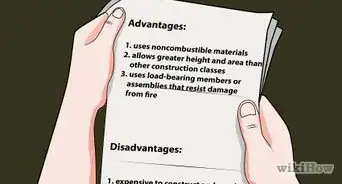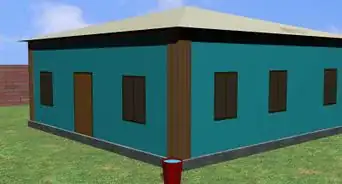This article was co-authored by Andrew Peters. Andrew Peters is an Architecture and Construction Specialist and a Principal at Peters Design-Build, a full service architecture and construction firm in the San Francisco Bay Area. With over 20 years of experience, Andrew specializes in sustainable and holistic design and building practices. Andrew holds a Bachelor of Architecture and a Project Management Professional (PMP) certification and is a Leadership in Energy and Environmental Design (LEED)-Accredited Professional. He served as Project Manager for the international-award-winning “Refract House,” Team California’s entry in the 2009 U.S. Department of Energy Solar Decathlon, a project featured in over 600 online and print articles.
There are 25 references cited in this article, which can be found at the bottom of the page.
wikiHow marks an article as reader-approved once it receives enough positive feedback. This article received 12 testimonials and 89% of readers who voted found it helpful, earning it our reader-approved status.
This article has been viewed 1,585,725 times.
Many people dream of building their own home. With such a huge project, however, it’s hard to know where to even begin. Fortunately, the process doesn’t have to be so daunting if you simply make a list of everything you need to do and the order you need to do it in. Start by purchasing a piece of land where you can break ground on your new home. Then, put together a house plan with the help of an architect and hire a team of builders to make your dream a reality.
Steps
Financing and Managing Your Project
-
1Set a realistic working budget for your project. The number you come up with will ultimately depend on what kind of disposable income you have, as well as the amount you’re willing to take out in loans. Devising a practical budget is key to focusing your vision and setting your sights on a plan you love that won’t leave you drowning in debt.
- When building your own home with the aid of a build contractor, you can expect to pay as much or more than you would if you were buying a house that’s already on the market.
- Every home is a little different, but for a 2,800 square foot single-family house, you’re looking at an average cost of around $290,000. That figure will only go up as you increase the square footage or add extra amenities.
-
2Find a piece of property to situate your new home on. If you don’t already have a site for your new home, your first step will be to acquire one. Start looking around for suitable places to build, keeping your preferences and financial limitations in mind, as well as the residential zoning laws for the area.[1]
- In many parts of the US, it’s possible to purchase a few acres of land for $20,000-50,000.[2]
- Quiet rural and suburban areas are especially popular among owner-builders
- Another option is to buy a lot in an existing development, then have your home built to your own specs. Just be sure to check with the owner of the development to find out if there particular building regulations in place that you might need to know about.
Advertisement -
3Apply for a construction loan to get the money you need to build. Once you’ve picked out the perfect spot for your new home, talk to a loan adviser at your bank about getting a construction loan to help you pay for it. With a construction loan, the bank will front you all or part of the cost for the property with the understanding that you’ll pay it back once your home is finished.[3]
- Don’t forget to bring a copy of your budget to the bank with you when you go in for your meeting.
- Securing a construction loan will allow you to take a piece of land off the market so that someone else can’t buy it before you do. It also gives you time to draw up a house plan and submit it to your local authority for approval.
Warning
Keep in mind that the house you build will serve as collateral for your construction loan, which means you could lose your home if you fail to pay off your loan.[4]
-
4Hire a realtor or buying agent to walk you through the building process. Research realtors and agents in your area and take some time to read customer testimonials to find one that comes recommended. Building a house is a complex project. For this reason, it’s strongly recommended that you have someone in your corner to help you navigate the many legal and financial details involved.[5]
- A realtor will serve as a liaison between you and the builder. They’ll communicate your wishes to your architect and building team, offer valuable cost-cutting advice, and take care of complicated legal tasks for you.[6]
- Don’t let budget concerns discourage you from working with a realtor. Their job is to minimize your project’s overhead, which means they’ll end up paying for themselves.
Planning Your New Home
-
1Draw up or purchase a detailed house plan. If you have prior experience building homes, you can design your own custom floorplan. Otherwise, your best bet is to go online and browse ready-made house plans until you find one that calls to you. Plans like these make excellent templates—you can always modify them later on to get everything exactly the way you want it.
- When selecting a house plan, be sure to consider factors like overall size, number of levels, and the general convenience and accessibility of the layout. Features like these will be especially important if you have a family.
- Premade house plans are most often priced by scale and level of detail. In general, you can expect to pay anywhere from $700 to $1,500 if you decide to buy a template online.
- Your house plan will be the blueprint for your new home. You and your building team will be referring back to it every step of the way, so it’s important to make sure that everything is in place.
Tip
Choosing a floorplan is one of the most crucial (and funnest) parts of building a new home, so take your time and look at many different plans to find one that matches your vision as closely as possible.
-
2Consult an architect for guidance with your house plan if you need help. While hiring an architect isn’t a necessity, it can be a big help if you feel like you’re in over your head with the design process. An architect can help you refine your building plans and deal directly with the building team to make sure construction runs smoothly.[7]
- If you don’t need an architect to hold your hand throughout the entire project, you also have the option of paying them for various services individually.
- Some architects charge an hourly or daily rate, while others claim a fixed percentage of the total cost of construction, typically 5-15%.[8]
-
3Submit your house plan to your city or county for approval. Once you’ve put the finishing touches on the floorplan, send it in to your local residential planning department. A panel of examiners will review your plans to make sure they meet all necessary building codes and zoning regulations. All prospective builders must submit plans for their new home, whether it's their first or their fifteenth.[9]
- If your plans are approved, you’ll be notified by phone or email and later receive a copy of the building permit by mail.
- If your plans are rejected, you’ll need to make the specified changes to the satisfaction of the department in order for them to be officially cleared for construction.
-
4Estimate the total cost of building your new home. Pull up a comprehensive home builder's checklist online and use it to make a note of each and every thing you expect to pay for. To ensure that your breakdown is as precise as possible, it should include not only the costs associated with general construction, but also secondary expenses such as painting, landscaping, and decorating.[10]
- It may help to create a chart dividing construction up into phases. Your first column could include land costs, building permits, and inspection fees, the next would contain foundation, framing, and roofing, and the later columns could be used to record the small finishing details.[11]
- Go over your cost estimate with your realtor or buying agent to make sure that everything is accounted for. Be prepared to make adjustments if your breakdown doesn’t fit your working budget.
Finalizing Your Building Preparations
-
1Hire a build contractor to oversee construction on your new home. The best way to find a qualified contractor is to talk to friends and associates who have built their own homes and see if they can offer a recommendation.[12] Once you’ve found someone who fits the bill, check to make sure that they’re properly licensed and bonded before you agree to work with them. This is a non-negotiable legal prerequisite in most states.[13]
- It’s also a good idea to ask prospective build contractors for a list of references, even if the law doesn’t require it. Get in touch with at least half of the references named to hear about their experience firsthand.
- Your general build contractor will be responsible for hiring out subcontractors to handle specialized work like plumbing, electrical wiring, roofing, window installation, and painting.[14]
Other Resources
If you don’t know anyone who has recently worked with a contractor they would recommend, browse websites like Home Advisor, Houzz, and Angie’s List to find a reputable professional with a good track record.[15]
-
2Work out a tentative construction schedule with your building crew. Sit down with your build contractor to discuss when each phase of building will begin and end. At the very least, try to establish a loose timeline for how the project will proceed. That way, you’ll have some idea of how soon they can get started, and when your home will be finished.[16]
- Check in with your contractor periodically to confirm that they’re sticking to the agreed-upon schedule.
- If you have no way of tracking the various milestones along the way, you’ll essentially be left at the mercy of your building crew.
-
3Draw up a formal contract with your builder. Commit all major details related to the project to paper. Your contract should include the contractor’s full contact information, estimated start and end dates, and an inventory of required materials, along with any special terms you and your builder have set. Make sure the language used is complete and clearly-worded so that you’ll have your bases covered in the event of a dispute.[17]
- You’ll also need to specify how your contractor will be paid in your contract. These days, contractors typically receive their money via Draw Reimbursement, which allows them to collect what they need as they go.[18]
- Have your realtor or attorney look over the contract with you before you sign it—they’ll be able to interpret any confusing provisions or terminology for you.
-
4Purchase builder’s insurance to avoid liability if necessary. Most qualified contractors carry their own insurance, which means you won’t need to bother with it. If for some reason yours doesn’t, take out an inexpensive plan that provides coverage for worksite accidents, catastrophes, vandalism, and theft. You’ll sleep better at night knowing that you’re off the hook in case of an emergency.[19]
- Ask your contractor for a copy of their policy to see what kind of protection it offers. If you don’t like what you see, you can always buy your own plan to improve your coverage.
- A basic builder’s insurance policy may run you $1,000-5,000 per year, depending on where you’re building and how big your project it.[20]
- Ordinarily, you won’t need a separate insurance policy if you’re having your home built in an existing community, subdivision, or development. You will, however, if you’re building on piece of private property.
Overseeing the Construction Process
-
1Begin by laying the foundation for your new home. The first thing your building crew will do when it’s time to get started is excavate the site you’ve picked out for your new home in preparation to pour the foundation. They’ll do this by pouring concrete into a series of “footer” boards that have been arranged to form the outline of the house and its individual rooms.[21]
- Additional ground shaping may be necessary if you’re planning to build your home on a hillside or other patch of uneven terrain.
- The foundation is arguably the most important part of a new home. Without a sturdy, well-laid foundation, even the nicest home may be plagued by structural problems.
-
2Put up the frame for your home’s internal structure. Next, your builders will begin cutting and assembling lumber for the frame, which will provide support for the walls, roof, and floor. This must be done with extreme care and precision according to the blueprint devised for your particular floorplan.[22]
- Framing should only be done by an experienced team of carpenters—every member must be in exactly the right place to ensure that the frame holds securely and satisfies regional safety standards.[23]
- This can prove to be one of the most time-consuming phases of construction, as adverse weather conditions such as rain have the potential to slow things down considerably.
-
3Build out the floor, walls, and roof. Once there’s a frame to work with, flooring, siding, and roofing subcontractors will be brought in to install your home’s main exterior surfaces. These rough surfaces are known collectively as “sheathing.” As soon as the sheathing is in place, your builders will surround the entire structure with house wrap, which is a type of waterproof barrier designed to prevent mold and moisture damage.[24]
- Roofing is an extensive job in itself, and will typically take longer to complete and inspect than the rest of the sheathing.[25]
- This is also when the outlines for exterior openings like doors and windows will be cut.
- Depending on how your contractor prefers to do things, they may opt to go ahead and install the siding and other exterior detailing immediately after the sheathing is done.[26]
- Water damage can destroy your home faster than anything else. To ensure your home is durable, make sure you really pay attention to the waterproofing of your roof, siding, doors, and windows outside, as well as your showers, sinks, and toilets indoors.[27]
-
4Integrate the rough plumbing, electrical, and HVAC systems. At this point, another team of subcontractors will begin outfitting your home’s basic structure with water pipes and supply lines, electrical wiring, and ductwork for heating and air conditioning. It’s important to put in the utility components while the contractors still have easy access to critical areas like wall framing and subfloors.[28]
- Your home’s pipes, ducts, and wiring will be covered up later on by drywall and other finishing details.
- In many cases, builders will install utility lines and sheathing simultaneously in order to make the most efficient use of their time.[29]
-
5Install insulation within the framing. Before drywall or other finishing surfaces are applied, your builders will fill the spaces in the wall and ceiling framing with some form of insulation. Insulation makes your home more energy efficient by helping it maintain a more consistent temperature range.[30] It also serves as an additional line of defense against moisture and pests.[31]
- There are many types of home insulation to choose from, including fiberglass, cellulose, mineral wool, spray foam, and concrete blocks. Talk to your general contractor about which type of insulation might work best for your home.
- Fiberglass and mineral wool insulations tend to be the least expensive to buy and install, while loose-fill cellulose and rigid foam insulations are among the most energy efficient options.[32]
Tip: Ensuring that your new home is properly insulated can end up saving you money on utilities down the line.
-
6Hang drywall and complete the remaining interior details. Your builders will now be ready to install the drywall needed for the interior walls. This involves securing and taping drywall sheets so that the seams between them aren’t visible, then smoothing on a primer coat of paint. While this is being done, they’ll also affix decorative trim to doors, windows, and other fixtures to give them a finished look.[33]
- Be sure to discuss your moulding preferences with your general contractor or subcontractor. You can decide on an actual color for your walls and trim later when it comes time to begin decorating.
-
7Install the flooring and countertops. The final task of primary construction is to put in all of the hard surfaces that will define the look of your new home. Your choice of style and material is totally up to you, so this will mostly be a matter of communicating what you want to your contractors. When picking out your surfaces, be sure to consider function as well as fashion.[34]
- Hardwood, tile, laminate, and carpet are all common flooring options. You could stick with a consistent theme throughout your entire home, or you might mix-and-match different materials in the same space.[35]
- Granite, ceramic, and concrete are some of the most sought-after countertop surfaces for busy kitchens. All of these materials are available in a wide range of colors that makes it easy to tie together any room.
- With all the major interior surfaces complete, you can move on to decorating and personalizing your new home.
Expert Q&A
Did you know you can get expert answers for this article?
Unlock expert answers by supporting wikiHow
-
QuestionDo I need to hire someone to build my house?
 GreatBuildzGreatBuildz is a free service that matches homeowners with reliable, pre-screened general contractors. GreatBuildz was founded by a team of real estate and construction experts who believe everyone deserves to find a great contractor, have a stress-free renovation, and enjoy their beautiful new space. GreatBuildz connects homeowners with reputable contractors who passed their rigorous screening process and signed their code of conduct. GreatBuildz also individually selects contractors for the specific project and provides ongoing support to ensure everything goes smoothly.
GreatBuildzGreatBuildz is a free service that matches homeowners with reliable, pre-screened general contractors. GreatBuildz was founded by a team of real estate and construction experts who believe everyone deserves to find a great contractor, have a stress-free renovation, and enjoy their beautiful new space. GreatBuildz connects homeowners with reputable contractors who passed their rigorous screening process and signed their code of conduct. GreatBuildz also individually selects contractors for the specific project and provides ongoing support to ensure everything goes smoothly.
Contractor Matching Service Many people choose to hire a general contractor for a home build. This is someone who has extensive knowledge of construction and coordinates the efforts of different specialized contractors, like plumbers and electricians. In general, a good contractor will let you know well in advance when they foresee delays in the schedule.
Many people choose to hire a general contractor for a home build. This is someone who has extensive knowledge of construction and coordinates the efforts of different specialized contractors, like plumbers and electricians. In general, a good contractor will let you know well in advance when they foresee delays in the schedule. -
QuestionHow can I build a home that will last for years?
 Andrew PetersAndrew Peters is an Architecture and Construction Specialist and a Principal at Peters Design-Build, a full service architecture and construction firm in the San Francisco Bay Area. With over 20 years of experience, Andrew specializes in sustainable and holistic design and building practices. Andrew holds a Bachelor of Architecture and a Project Management Professional (PMP) certification and is a Leadership in Energy and Environmental Design (LEED)-Accredited Professional. He served as Project Manager for the international-award-winning “Refract House,” Team California’s entry in the 2009 U.S. Department of Energy Solar Decathlon, a project featured in over 600 online and print articles.
Andrew PetersAndrew Peters is an Architecture and Construction Specialist and a Principal at Peters Design-Build, a full service architecture and construction firm in the San Francisco Bay Area. With over 20 years of experience, Andrew specializes in sustainable and holistic design and building practices. Andrew holds a Bachelor of Architecture and a Project Management Professional (PMP) certification and is a Leadership in Energy and Environmental Design (LEED)-Accredited Professional. He served as Project Manager for the international-award-winning “Refract House,” Team California’s entry in the 2009 U.S. Department of Energy Solar Decathlon, a project featured in over 600 online and print articles.
Architecture & Construction Specialist Water intrusion causes rot, and that's what ultimately destroys buildings faster than anything else. Take care of your waterproofing—make sure you have a robust waterproof roof system, siding, doors, and windows. On the interior, make sure you waterproof wet spaces like toilets, showers, and bathtubs.
Water intrusion causes rot, and that's what ultimately destroys buildings faster than anything else. Take care of your waterproofing—make sure you have a robust waterproof roof system, siding, doors, and windows. On the interior, make sure you waterproof wet spaces like toilets, showers, and bathtubs. -
QuestionHow can I make my home more energy efficient?
 Andrew PetersAndrew Peters is an Architecture and Construction Specialist and a Principal at Peters Design-Build, a full service architecture and construction firm in the San Francisco Bay Area. With over 20 years of experience, Andrew specializes in sustainable and holistic design and building practices. Andrew holds a Bachelor of Architecture and a Project Management Professional (PMP) certification and is a Leadership in Energy and Environmental Design (LEED)-Accredited Professional. He served as Project Manager for the international-award-winning “Refract House,” Team California’s entry in the 2009 U.S. Department of Energy Solar Decathlon, a project featured in over 600 online and print articles.
Andrew PetersAndrew Peters is an Architecture and Construction Specialist and a Principal at Peters Design-Build, a full service architecture and construction firm in the San Francisco Bay Area. With over 20 years of experience, Andrew specializes in sustainable and holistic design and building practices. Andrew holds a Bachelor of Architecture and a Project Management Professional (PMP) certification and is a Leadership in Energy and Environmental Design (LEED)-Accredited Professional. He served as Project Manager for the international-award-winning “Refract House,” Team California’s entry in the 2009 U.S. Department of Energy Solar Decathlon, a project featured in over 600 online and print articles.
Architecture & Construction Specialist
Warnings
- Building your own home can be extremely stressful, as it demands a lot of time, energy, and attention to detail. Make sure you’re up to the task before you make the commitment and end up over your head. By then, it will be too late to turn back.⧼thumbs_response⧽
References
- ↑ https://realestate.usnews.com/real-estate/articles/the-dos-and-donts-of-buying-vacant-land
- ↑ https://www.moneyunder30.com/is-it-cheaper-to-build-your-own-home-than-buy-one
- ↑ https://www.nerdwallet.com/blog/mortgages/construction-loans/
- ↑ https://realestate.usnews.com/real-estate/articles/the-dos-and-donts-of-buying-vacant-land
- ↑ https://www.realtor.com/advice/buy/should-you-go-it-alone-when-buying-from-home-builder/
- ↑ https://www.youtube.com/watch?v=99vVvznj0P8&feature=youtu.be&t=70
- ↑ https://www.curbed.com/2018/1/29/16945396/architect-hiring-questions-renovation
- ↑ https://buildingadvisor.com/your-team/architects/#Architect%20Fees
- ↑ http://www.cityofchesapeake.net/government/city-departments/departments/Department-of-Development-and-Permits/Building-Permits-and-Inspections/bldg_plan_review/residential-planapproval.htm
- ↑ https://www.homeadvisor.com/cost/architects-and-engineers/build-a-house/
- ↑ http://www.nahbclassic.org/generic.aspx?genericContentID=260013
- ↑ GreatBuildz. Contractor Matching Service. Expert Interview. 25 November 2020.
- ↑ GreatBuildz. Contractor Matching Service. Expert Interview. 25 November 2020.
- ↑ GreatBuildz. Contractor Matching Service. Expert Interview. 25 November 2020.
- ↑ https://www.consumerreports.org/home-improvement/can-you-find-a-good-contractor-online/
- ↑ https://www.youtube.com/watch?v=99vVvznj0P8&feature=youtu.be&t=147
- ↑ https://www.consumer.ftc.gov/articles/0242-hiring-contractor#Before
- ↑ https://www.porterwright.com/media/construction-loan-draw-procedures-residential-and-commercial/
- ↑ https://www.staufferandsons.com/blog/understanding-insurance-when-building-a-new-home/
- ↑ https://fitsmallbusiness.com/builders-risk-insurance/
- ↑ https://www.projex.com.au/blog/ultimate-step-step-guide-building-house-foundations-roof/
- ↑ https://extremehowto.com/understanding-house-framing/
- ↑ https://www.safewise.com/blog/home-building-timeline-keep-sane/
- ↑ https://www.newhomesource.com/guide/articles/a-step-by-step-guide-to-the-home-building-process
- ↑ https://www.familyhandyman.com/roof/how-to-roof-a-house/view-all/
- ↑ https://www.projex.com.au/blog/ultimate-step-step-guide-building-house-foundations-roof/
- ↑ Andrew Peters. Architecture & Construction Specialist. Expert Interview. 24 November 2020.
- ↑ https://www.newhomesource.com/guide/articles/a-step-by-step-guide-to-the-home-building-process
- ↑ https://www.projex.com.au/blog/ultimate-step-step-guide-building-house-foundations-roof/
- ↑ Andrew Peters. Architecture & Construction Specialist. Expert Interview. 24 November 2020.
- ↑ https://www.projex.com.au/blog/ultimate-step-step-guide-building-house-foundations-roof/
- ↑ https://www.energy.gov/energysaver/weatherize/insulation/types-insulation
- ↑ https://www.safewise.com/blog/home-building-timeline-keep-sane/
- ↑ https://www.newhomesource.com/guide/articles/a-step-by-step-guide-to-the-home-building-process
- ↑ https://www.moneycrashers.com/best-home-flooring-ideas-and-options/
About This Article
To build your own home in the US, first you'll need to purchase some property to build your home on. If you need help paying for the land or your new home, consider applying for a construction loan through your bank so you can finance your house and then pay it off later. Also, you might want to hire a realtor or buying agent to help you navigate the home-building process. Then, once you've secured funding, you can start designing your home on your own or with the help of an architect. To learn how to start the construction process on your new home, scroll down!
-Step-1-Version-3.webp)
-Step-2-Version-3.webp)
-Step-3-Version-3.webp)
-Step-4-Version-3.webp)
-Step-5-Version-3.webp)
-Step-6-Version-3.webp)
-Step-7-Version-3.webp)
-Step-8-Version-3.webp)
-Step-9-Version-3.webp)

-Step-10-Version-3.webp)
-Step-11-Version-3.webp)
-Step-12-Version-2.webp)
-Step-13-Version-2.webp)
-Step-14-Version-2.webp)
-Step-15-Version-2.webp)

-Step-16-Version-2.webp)
-Step-17-Version-2.webp)
-Step-18-Version-2.webp)
-Step-19-Version-2.webp)
-Step-18.webp)





















-Step-18.webp)





































